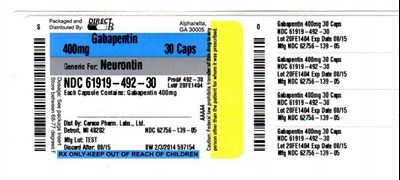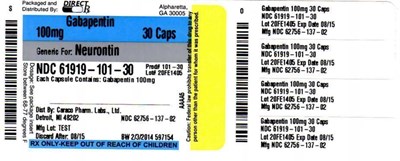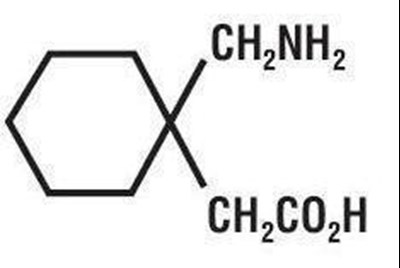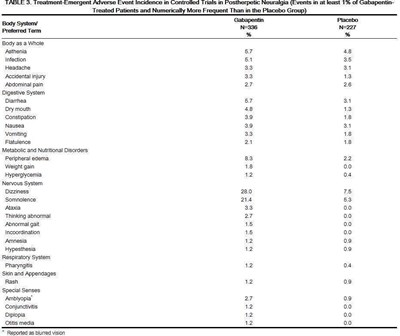Product Images Gabapentin
View Photos of Packaging, Labels & Appearance
- image description - DOSAGE
- image description - FIGURE1
- image description - FIGURE2
- image description - FIGURE3
- image description - FIGURE4
- image description - GABA300LABEL
- image description - GABA400LABEL
- image description - GABAPENTIN100LABEL
- image description - MOLECULESTRUCTURE
- image description - TABLE13
- image description - TABLE2 1
- image description - TABLE2 2
- image description - TABLE3
- image description - TABPE5
- image description - WARNINGSTABLE
Product Label Images
The following 15 images provide visual information about the product associated with Gabapentin NDC 61919-492 by Direct Rx, such as packaging, labeling, and the appearance of the drug itself. This resource could be helpful for medical professionals, pharmacists, and patients seeking to verify medication information and ensure they have the correct product.
image description - DOSAGE

This text is a dosage guide for Gabapentin based on renal function. It provides recommended doses for patients with varying levels of renal function, including supplemental post-hemodialysis doses for patients undergoing hemodialysis. Patients with creatinine clearance below 15 mL/min should have reduced daily doses.*
image description - FIGURE1

The text describes a graph that shows the weekly mean pain scores during a study. The study consisted of a 4-week dose titration period followed by a 4-week fixed dose period. The study compared the effects of a placebo and Gabapentin at a daily dose of 3600 mg. The graph shows that Gabapentin significantly reduced pain scores compared to placebo. The text also includes a statistical significance value of p<0.01.*
image description - FIGURE2

The image shows a graph depicting the weekly mean pain scores of Study 2, during a 3-week dose titration period followed by a 4-week fixed dose period, using a placebo and two doses of gabapentin. The graph indicates that both doses of gabapentin had a statistically significant decrease in pain scores compared to the placebo.*
image description - FIGURE3

The text describes the results of controlled PHN studies, showing the percentage of responders (patients with >50% reduction in pain score) at endpoint. The studies compared PBO (placebo) and GBP (unknow medication). There are two studies represented (Study 1 and Study 2) and the graph (Figure 3) shows the proportion of responders at different dosages (3600, 1800, and 2400). Additionally, there are statistical values represented indicating the level of significance (p<0.01 and p<0.001).*
image description - FIGURE4

The text describes a figure showing the Responder Rate in Patients Receiving Gabapentin as a difference from placebo, based on dose and study. Gabapentin was used as an adjunctive therapy in patients over 12 years of age with partial seizures. The figure shows daily doses of 600mg, 900mg, 1200mg, and 1800mg. No other information is available.*
image description - GABA300LABEL

This is a description of a Gabapentin medication bottle containing 60 capsules of 300mg each. The capsules are manufactured by Neurontin and contain gabapentin USP. The Lot Fxp Date is 82117. The rest of the text is not clear and cannot be deciphered.*
image description - GABA400LABEL

This is a description of a medication called Gabapentin, in the form of 30 capsules, each containing 400mg of the active ingredient. The medication is manufactured by NDC 62756-13905 and has an expiration date of 08/15 identified by the Lot number 20FE1404. The medication is also identified by NDC 61919482-30 and NDC 61919432-30. A batch of the medication labeled with Lot number 20FE1404 is the same in each case. The system has produced some non-English characters that have been omitted from this description.*
image description - GABAPENTIN100LABEL

This is a description of Gabapentin capsules of 100mg strength. The capsules are distributed by AohErEE LLC at GA 30005. The manufacturer's number is NOC 61919-101-30. Each capsule of Gabapentin contains 100mg of the medicine. There are 30 capsules per bottle. The lot number of the medicine is 20FE1405, and the expiration date is 08/15. The manufacturer's National Drug Code (NDC) is 62756-137-02.*
image description - TABLE2 1

This appears to be a table presenting information about treatment-emergent adverse events in controlled add-on trials for patients over the age of 12 who were taking gabapentin. The table displays the incidence of adverse events that occurred in at least 1% of gabapentin patients and were more frequent than in the placebo group. The only adverse event listed in the table is coughing, with 18 cases reported among the gabapentin patients and 13 cases among the placebo group.*
image description - TABLE2 2

This document appears to be a medical record that lists some physical symptoms, laboratory deviations, and ongoing treatment of a patient. The patient is experiencing skin abrasions and itching, and may be experiencing vision issues such as Diplopia and Amolyopia. They are also experiencing impotence and a decreased white blood cell count. The asterisk denotes that the patient is currently on some sort of anti-seizure medication.*
image description - TABPE5

This is a table that shows the incidence of treatment-emergent adverse events in pediatric patients aged 3 to 12 years in a controlled add-on trial of Gabapentin. It shows the adverse events that occurred in at least 2% of Gabapentin patients and were numerically more frequent than in the placebo group. The adverse events are categorized into different body systems such as Body As A Whole, Digestive System, Nervous System, and Respiratory System. The adverse events that occurred more frequently in the Gabapentin group compared to the placebo group include Viral Infection, Weight Increase, and Somnolence. However, this study was done with background antiepileptic drug therapy.*
* The product label images have been analyzed using a combination of traditional computing and machine learning techniques. It should be noted that the descriptions provided may not be entirely accurate as they are experimental in nature. Use the information in this page at your own discretion and risk.


